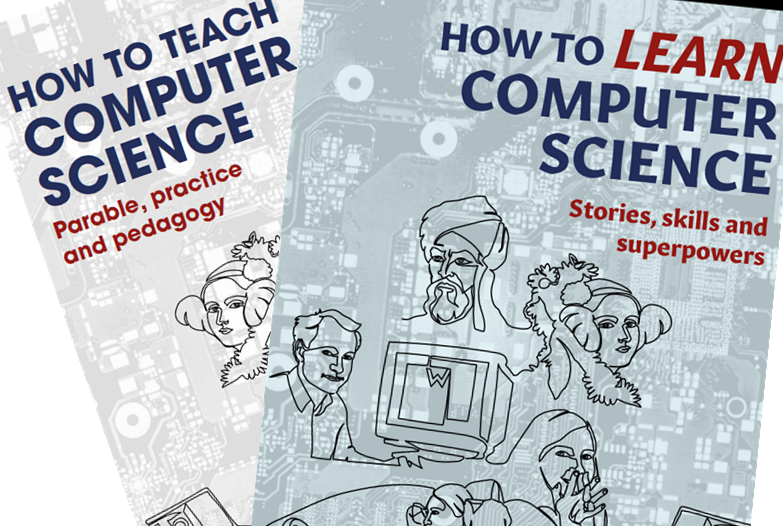This is a sneak preview of an article I wrote for Hello World magazine, whose “Big Book of Computing Pedagogy” is out now!
The Core and the Hinterland – why reading around the subject improves your teaching.
Having a laser-like focus on the exam board specification while teaching GCSE is extremely worthwhile: the exam is, after all, how they will be assessed. Knowing the difference between a worm and a virus will gain a mark. What won’t score on the exam is knowing that the first worm, called “Creeper”, dates back to 1971. Telling the examiner that the worm’s author Bob Thomas of BBN wrote the “Reaper” worm to get rid of “Creeper” is also pointless. But the teacher that knows this “hinterland” knowledge and can share it with their students brings colour and interest to the subject which can improve engagement. And teachers of Key Stage 3 and earlier should be delivering a rich curriculum that is enjoyable in its own right, while also laying the groundwork for GCSE studies. In short, there is great pedagogical value in exploring the hinterland with your students.
What are “core” and “hinterland”?
We can think of the core as the examinable material, what do they need to know to pass the exam? But as Christine Counsell warns in her 2018 blog: “if for the purposes of teaching, we reduce it to those propositions, we may make it harder to teach, and at worst, we kill it.” [1]
Counsell makes the point that students of English who commit to memory the plot, characters and stylistic features of a text from the revision guide will undoubtedly do well, but a true understanding can only be gained by “reading, bathing in the text, delighting in the text, alone and with others.”ibid
In his blog post “Signposting the hinterland…”, Tom Sherrington explains that the hinterland is as important as the core, and serves the purpose of:
- increasing depth: niche details about a particular area of study that deepen and enrich the core.
- increasing breath: wider surveys across the domain of any curriculum area that help to locate any specific core element within a wider frame. [2]
Sherrington give several examples including a music teacher sharing “a timeline of musical genres through samples from Purcell to Bjork – something we reference repeatedly as we explore our chosen composers in more depth”.
What is our hinterland?
Like the music teacher, we too can illuminate the subject with reference to the past. The backstory of computing is interwoven with world history and I regularly discuss new learning in the context of historical events. Teaching algorithms? Start with the origin of the word (Persian scholar Al-Khwarizmi of the Islamic Golden Age) and discuss how John von Neumann (yes, he of the architecture) devised Merge Sort to crunch numbers for the atomic bomb that fell on Nagasaki. Explaining validation? Tell the story of Margaret Hamilton’s Apollo computer “Lauren bug” and why it caused her to invent Software Engineering. [3]
We can find a computing “angle” in almost any event of recent history. From the encrypted messages sent during the Babington Plot against Elizabeth I to the problem of racial bias in algorithms used by 21st century police forces, bringing these narratives into class helps illuminate the topic, improve engagement and make learning stick around in long-term memory.
Why is hinterland important?
The new Ofsted inspection framework requires us to give learners the “cultural capital to succeed in life.”[4] The phrase “cultural capital” is often summarised as “the best which has been thought and said”, and as such it is the legacy left to us by the great minds of the past, and every child’s birthright. Computer science hinterland knowledge can also help learners build their cultural and science capital which is important if they are to see themselves as scientists or even computer scientists.[5]
Several of the pedagogy principles published by the NCCE[6] can be delivered through exploration of the hinterland, in particular the reference to storytelling in their advice to “make concrete” the learning (see box).
Bring abstract concepts to life with real world, contextual examples and a focus on interdependencies with other curriculum subjects. This can be achieved through the use of unplugged activities, proposing analogies, storytelling around concepts, and finding examples of the concepts in pupils’ lives.
NCCE 12 principles of computing pedagogy link
The hinterland paradox
Science and pedagogy blogger Adam Boxer makes clear the paradox of core and hinterland in his blog:
“there is content which we wish students to remember, and by contrast content we don’t deem necessary for them to remember. [But] without the ‘stuff we don’t need our students to remember,’ our curriculum becomes denuded of wider meaning and majesty: it ceases to be one thread of the epic story of humanity and becomes a sterile and sanitised exam-ready product.” [7]
It can be hard to solve this paradox, but teachers would do well to not shy away from the hinterland at all costs. I know that when I delve into the hinterland the learners are usually engaged and find it valuable. Indeed the “Von Neumann’s Merge Sort led to the Atom Bomb” story got a round of applause, that I am telling myself wasn’t entirely ironic!
The full article will appear in a future edition of Hello World magazine.
[1] ” Senior Curriculum Leadership 1: The indirect manifestation of knowledge: (A) curriculum as narrative” – Counsell, C. 2018. https://thedignityofthethingblog.wordpress.com/2018/04/07/senior-curriculum-leadership-1-the-indirect-manifestation-of-knowledge-a-curriculum-as-narrative/
[2] “Signposting the hinterland: practical ways to enrich your core curriculum.”, Sherrington, T. 2019 https://teacherhead.com/2019/09/27/signposting-the-hinterland-practical-ways-to-enrich-your-core-curriculum/
[3] “How to Teach Computer Science”, Harrison, A.J., 2021, John Catt Educational
[4] Education inspection framework (EIF), Ofsted 2019 https://www.gov.uk/government/publications/education-inspection-framework/education-inspection-framework
[5] “Science Capital: making science relevant”, STEM learning blog 16 Jul 2019, https://www.stem.org.uk/news-and-views/opinions/science-capital-making-science-relevant
[6] Teach Computing quick reads, teachcomputing.org/pedagogy
[7] Core and hinterland: What’s what and why it matters, Boxer, Adam, 2019, https://achemicalorthodoxy.wordpress.com/2019/02/01/core-and-hinterland-whats-what-and-why-it-matters/
